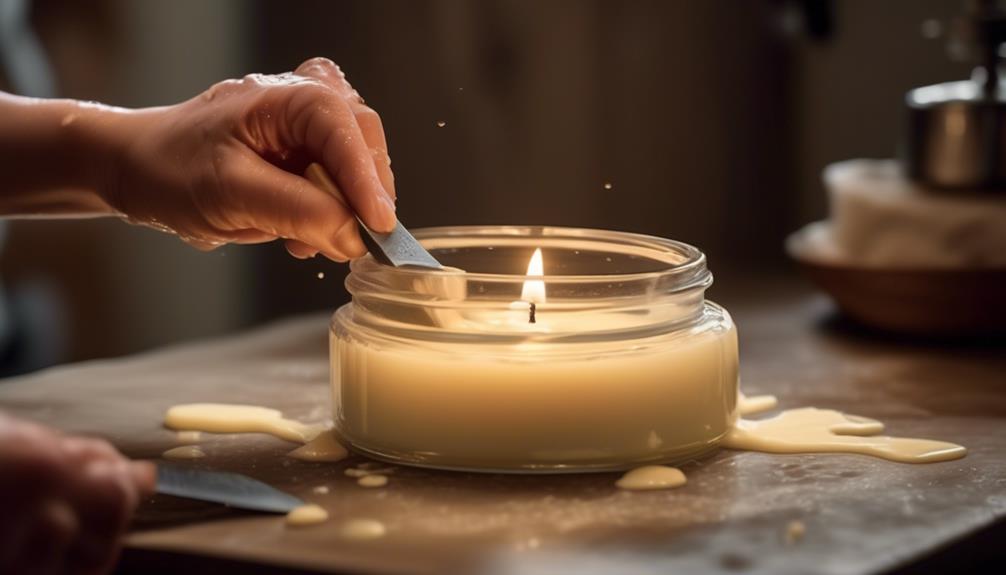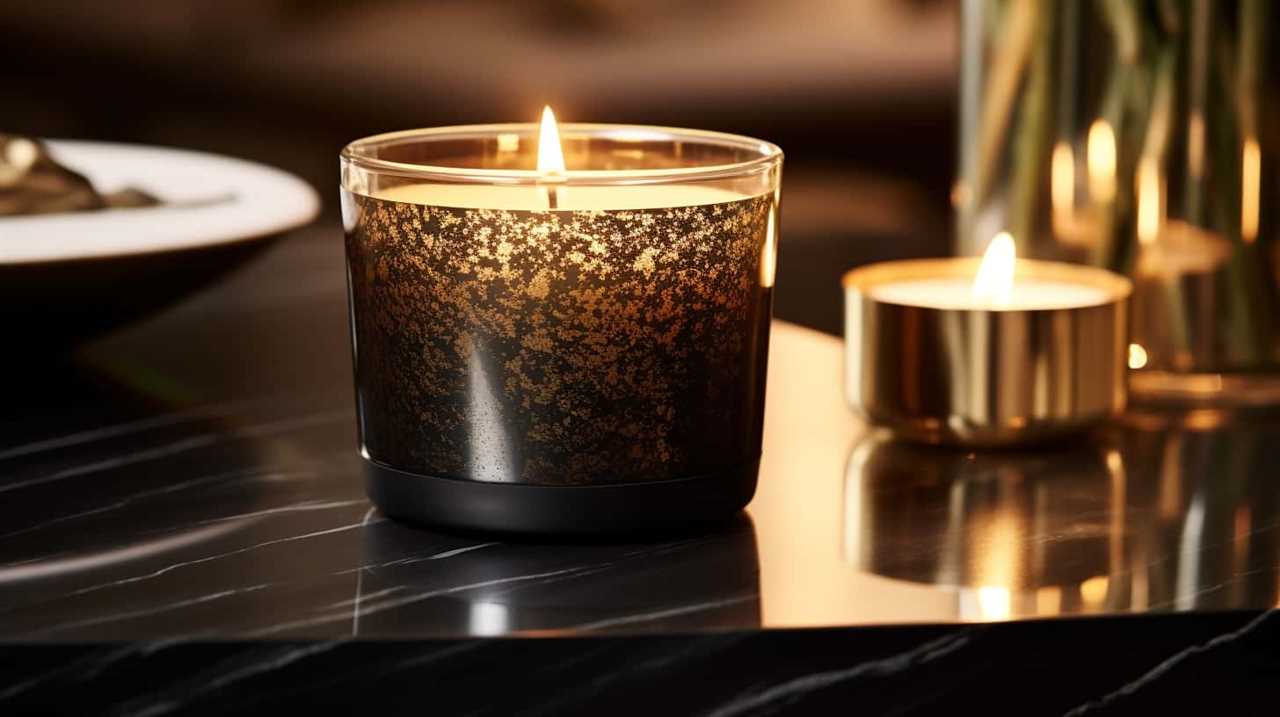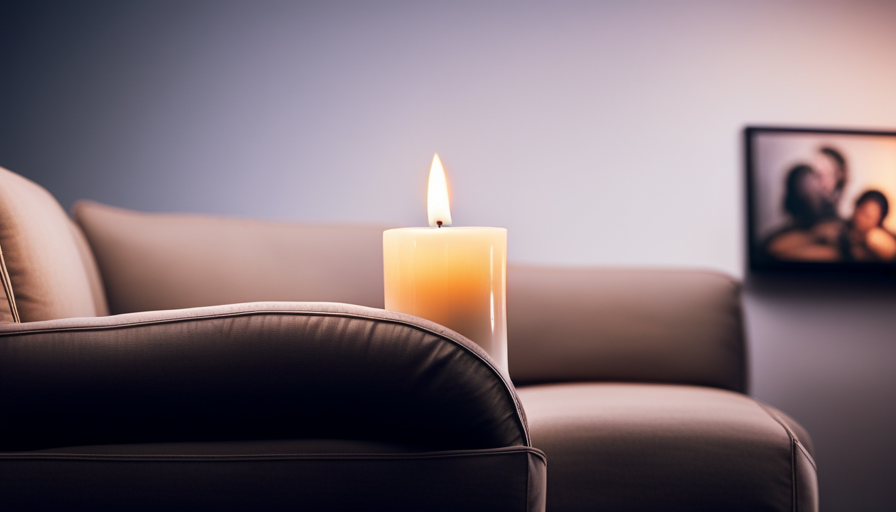When it’s time to clean out a candle jar, there are easy methods that can help simplify the process. Whether you choose to use boiling water or freezing methods, there are numerous effective ways to get the job done.
By exploring different approaches, you can choose the one that suits your needs and preferences best. Let's uncover the secrets to reviving your candle jars and giving them a fresh start.
Key Takeaways
- Boiling water and freezer techniques are effective for cleaning out candle jars.
- The oven cleaning process can be used to remove grime from oven racks.
- Repurpose candle containers as cotton ball holders, desk organizers, herb planters, or makeup brush holders.
- Tea light holders are a cozy and practical use for cleaned candle jars.
Boiling Water Method
To easily clean out a candle jar using the Boiling Water Method, we recommend carefully pouring boiling water into the jar. This method is effective for removing candle wax residue without causing any damage to the jar. Here's a step-by-step guide on how to clean out a candle jar using boiling water:
- Prepare the Jar: Ensure the candle jar is empty and has cooled down after use.
- Boil Water: Boil a sufficient amount of water in a kettle or pot.
- Pour Boiling Water: Slowly and carefully pour the boiling water into the candle jar. Fill it up to just below the rim.
- Let it Sit: Allow the boiling water to cool down in the jar. As the water cools, it will melt the wax, causing it to rise to the surface.
- Remove the Wax: Once the water has cooled completely, you can easily remove the wax that has floated to the top using a paper towel or a spoon.
- Clean the Jar: Finally, wash the jar with warm soapy water to remove any remaining residue.
Freezer Technique

After utilizing the Boiling Water Method to clean out a candle jar effectively, another practical technique is the Freezer Technique.
To start, place the candle jar in the freezer overnight. The cold temperature will cause the wax to harden and shrink, making it easier to remove.
Once frozen, the wax should pop right out of the container. Next, use a butter knife or spoon to scrape off any remaining wax residue. Make sure to be gentle to avoid damaging the jar.
After removing the wax, clean the jar with soap and water to eliminate any leftover wax or debris. This step is crucial to ensure the jar is thoroughly clean and ready for reuse or repurposing.
The Freezer Technique is a simple yet effective method for cleaning out candle jars, providing a hassle-free way to enjoy your favorite candles while keeping the containers in excellent condition for future use.
Oven Cleaning Process
To start the oven cleaning process, preheat the oven to the recommended temperature for safety.
Once preheated, place the dirty oven racks on a baking sheet or aluminum foil inside the oven to melt the residue easily.
Let the racks sit for a few hours to loosen grime before removing.
Scrub the racks with warm water and dish soap.
Rinse the racks thoroughly.
Dry the racks for a sparkling finish.
Preheat Oven Safely
Before preheating the oven for the cleaning process, ensure all racks and trays have been removed to prevent any accidents.
When preheating the oven, follow these crucial steps:
- Check for Residual Wax: Make sure there's no leftover wax in the oven from previous cleaning processes.
- Set the Temperature: Preheat the oven to a low temperature, around 150-200°F (65-93°C), to soften the wax inside the jar.
- Monitor Closely: Keep a close eye on the jar in the oven to prevent any overheating or accidental spills.
Following these steps will ensure a safe and effective way to clean out the candle jar without causing any damage to the oven or risking any safety hazards.
Melt Residue Easily
For an efficient cleaning process, consider utilizing a phrasal verb to expedite the melting of residue in the oven. To melt residue easily from a candle jar, preheat the oven to 200 degrees Fahrenheit. Line a baking sheet with aluminum foil and place the spent candles upside-down on the foil. Place the baking sheet in the oven and monitor the candles closely. After about 15 minutes, the wax should pool on the foil. Remove the jars using an oven mitt, let them cool, and clean with soap and warm water.
| Candle Jar | Water |
|---|---|
| Melting Residue | Easy Cleanup |
| Oven Method | Efficient |
| Wax Removal | Quick Process |
| Cleaning | Hassle-free |
Hair Dryer Hack
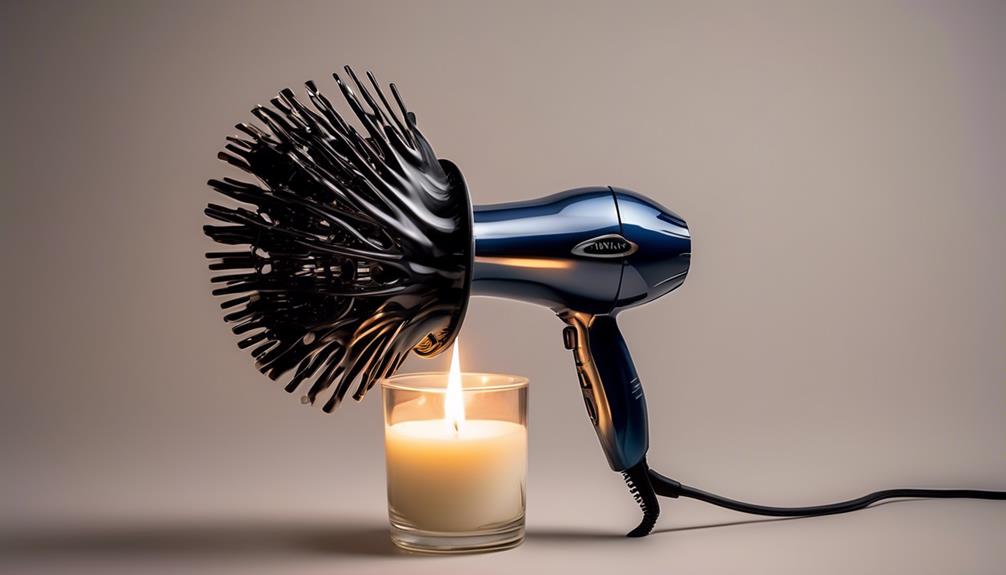
Using a hair dryer on high heat can help melt the remaining wax residue in the candle jar, making it easier to clean out completely. This method is particularly useful for stubborn wax that's hard to remove using traditional techniques. To effectively utilize this hair dryer hack, follow these steps:
- Prepare the Candle Jar: Ensure the candle jar is at room temperature and free from any debris or wick remnants.
- Apply Hot Air: Hold the hair dryer a few inches away from the jar and turn it to the highest heat setting. Move the dryer around the inside of the jar to evenly distribute the hot air.
- Scrape Off Melted Wax: As the wax begins to melt, you can use a paper towel or a butter knife to gently remove the softened wax from the sides of the jar. Be cautious not to scratch the glass.
Once the majority of the wax is melted and removed, you can proceed with cleaning the jar using hot water and soap to get it sparkling clean.
Cleaning Candle Jars

When cleaning candle jars, start by removing any wax residue with hot water and a thorough wash with soap.
Make sure to dry the jar completely before reusing or storing it to prevent mold growth.
Following these steps will help keep your candle jars clean and ready for future use.
Removing Wax Residue
To effectively remove wax residue from a candle jar, there are several methods that can be used. One method is the hot water method, which involves pouring boiling water into the jar and allowing the wax to float to the surface. Once the wax has risen to the top, it can be easily strained and the container can be cleaned.
Another method is the freezing method. This involves placing the jar in the freezer overnight and then flipping it upside down to easily remove the frozen wax. This method is particularly useful for jars that have a more stubborn wax residue.
The oven method is another option for removing wax from a candle jar. To use this method, the jar is heated upside down on a baking sheet at 200 degrees Fahrenheit. As the jar heats up, the wax will pool on the foil, making it easy to remove. After the wax has been removed, the jar can be cleaned with soap and water.
These techniques are effective in ensuring a clean candle jar that can be reused or repurposed.
Washing With Soap
We find that applying a generous amount of dish soap and warm water to the candle jar is an effective way to begin the cleaning process.
To remove the jar, first, fill it with hot water and let it sit for a few minutes to loosen any remaining wax residue.
Then, add a few drops of dish soap to the water and use a sponge to scrub the inside of the jar thoroughly.
Rinse the jar with warm water to remove all soap residue.
For stubborn wax or soot stains, a paste of baking soda and water can be applied and scrubbed gently.
Drying Thoroughly
After thoroughly scrubbing the inside of the candle jar with soap and warm water to ensure it's clean, the next crucial step is to dry it thoroughly to prevent any moisture-related issues or mold growth. Here's how to ensure your candle jar is dried properly:
- Remove any remaining water: Use a clean, dry cloth to carefully wipe the inside of the jar to remove any excess water.
- Air dry upside down: Place the jar upside down on a clean towel or drying rack to allow all water to drip out and the jar to air dry completely.
- Check for dryness: Ensure the jar is completely dry inside and out before storing or reusing it.
Repurposing Candle Containers
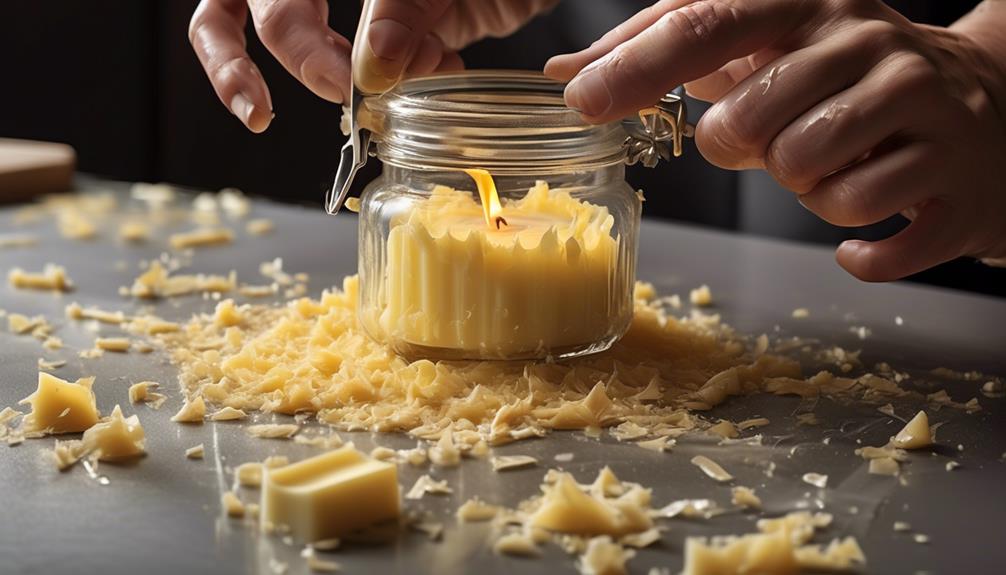
Transforming candle containers into functional and stylish storage solutions is a smart way to repurpose these decorative items. After removing wax and cleaning out your candle jar with hot, soapy water, you can give it a new life by turning it into a useful storage container. Here's a step-by-step guide on repurposing candle containers:
| Ideas for Repurposing Candle Containers | Description |
|---|---|
| Cotton Ball Holder | Use the jar to store cotton balls or pads in your bathroom for easy access. |
| Desk Organizer | Organize small office supplies like paper clips, rubber bands, or push pins. |
| Herb Planter | Create a mini herb garden by planting herbs in the jar for a fresh touch to your kitchen. |
Freezing Wax Removal
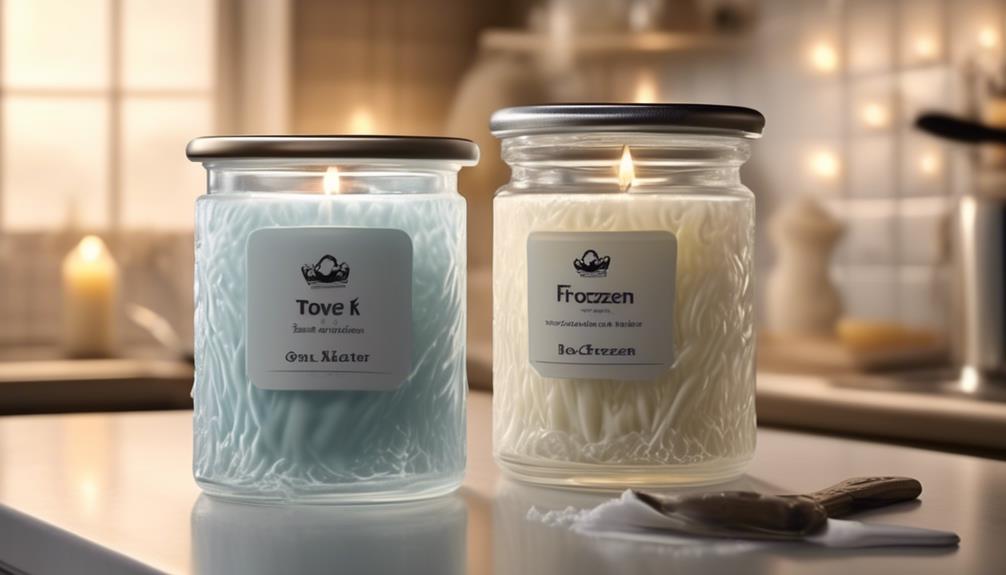
To repurpose a candle container for storage, the next step involves freezing the remaining wax for easy removal. Here's how to do it effectively:
- Prepare the Candle Jar: Place the candle jar on a heat-safe surface to protect your countertops or tables.
- Freeze the Wax: Place the candle jar in the freezer overnight. The cold temperature will solidify the wax, making it easier to remove.
- Remove the Wax: After freezing, take out the jar and use a butter knife or a spoon to gently pry the wax from the sides. The frozen wax should come out in chunks.
Once you have removed most of the wax, there may still be some residue left. To clean the jar thoroughly, you can pour boiling water into the jar to melt any remaining wax. Allow the water to cool, then strain it to separate the wax from the water.
With these steps, you can effectively remove wax from a jar and prepare it for a new use.
Boiling Water Trick
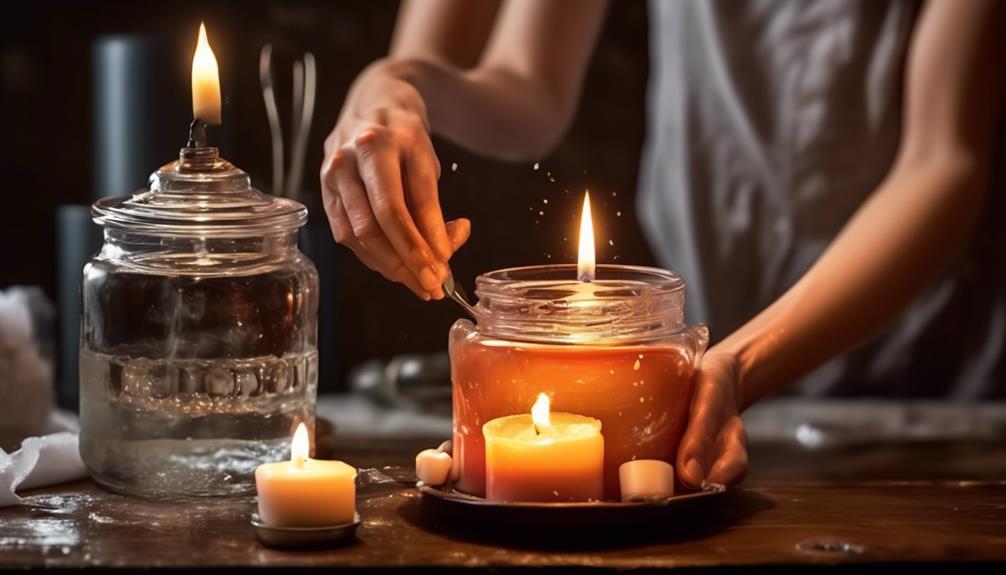
For effectively utilizing the boiling water trick to clean out a candle jar, start by heating water in a kettle until it reaches a near-boiling temperature. Carefully pour the hot water into the candle jar, ensuring it covers all the leftover wax. Let the jar sit for about 10-15 minutes to allow the hot water to soften and melt the wax. The heat from the water will cause the wax to loosen its grip on the glass walls of the jar.
After letting the jar sit, take a butter knife or a spoon and gently scrape the softened wax from the sides of the jar. Be cautious not to scratch the glass. The softened wax should easily come off with minimal effort. Dispose of the wax residue properly.
Next, pour out the water and wax remnants into a disposable container or wipe it clean with paper towels. Wash the jar with warm, soapy water to remove any remaining wax residue. Finally, dry the jar thoroughly before reuse.
The boiling water trick is a simple and effective method for removing wax residue from candle jars.
Oven Melting Method

When using the Oven Melting Method to clean out candle jars, it's essential to follow these steps:
- Preheat the oven to a safe temperature range of 200 degrees Fahrenheit.
- Line a baking sheet with aluminum foil.
- Carefully place the spent candles upside-down on the baking sheet to monitor the melting progress.
- After about 15 minutes, the wax should pool on the foil, signaling that it's time to remove the jars for cleaning.
Remember to exercise caution when handling hot jars and melted wax.
Safe Temperature Range
As we preheat the oven to the recommended temperature range for melting wax, typically around 180-200 degrees Fahrenheit, we ensure a safe and efficient process for cleaning out candle jars using the oven melting method.
- Monitor Closely: Keep a close eye on the candles to prevent exceeding the safe temperature range.
- Use Oven Mitts: Always wear oven mitts when handling hot jars to avoid burns or accidents.
- Clean with Care: After cooling, wipe the jars with a paper towel to remove any remaining wax residue before washing with warm, soapy water.
Following these steps will help you safely and effectively clean out your candle jars using the oven melting method.
Monitoring Melting Progress
To ensure successful monitoring of the melting progress during the oven melting method, it is crucial to preheat the oven to the recommended temperature range of approximately 200 degrees Fahrenheit. Place the candle jars upside down on a lined baking sheet and keep a close eye on the jars as the wax melts, checking every 10-15 minutes. A monitoring melting progress table could help track the remaining wax in the jars:
| Time Elapsed | Wax Melting Progress |
|---|---|
| 0 minutes | Solid wax |
| 10 minutes | Wax starting to melt |
| 20 minutes | Wax halfway melted |
| 30 minutes | Wax completely melted |
When the wax has completely melted and pooled on the baking sheet, remove the jars from the oven. Allow the jars to cool before cleaning them with soap and warm water.
Double Boiler Tip

Wondering how to effectively melt the wax in a candle jar without direct heat? When using the double boiler method, follow these steps for optimal results:
- Set up a double boiler by filling a pot with water and placing a heat-safe bowl or smaller pot on top.
- Place the candle jar in the heat-safe bowl or pot, ensuring it doesn't touch the water below.
- Heat the water in the double boiler until it simmers, allowing the indirect heat to melt the wax in the jar.
Soft Wax Spooning
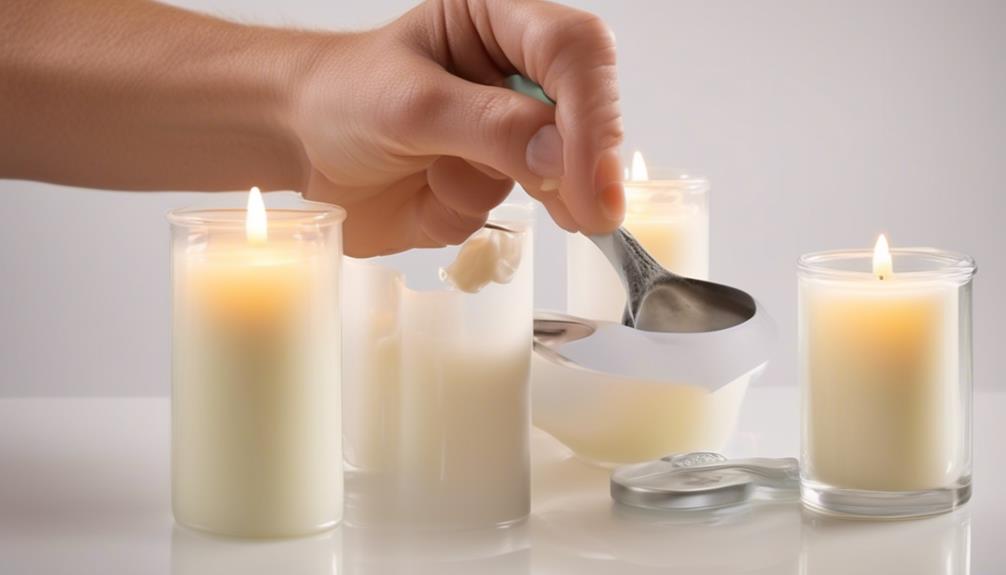
After successfully melting the wax using the double boiler method, the next step in cleaning out a candle jar involves softly spooning out the softened wax. Once the candle jar has cooled completely, use a butter knife or spoon to gently scoop out the soft wax from the jar. It's crucial to handle this step delicately to avoid scratching or damaging the jar. Carefully continue spooning out the wax until all the softened wax has been removed from the jar.
As you spoon to remove the leftover wax, be mindful of the edges and bottom of the jar to ensure a thorough cleaning. Take your time and work methodically to avoid leaving any wax residue behind. Once all the soft wax has been successfully scooped out, proceed to clean the jar with warm, soapy water to eliminate any remaining traces of wax.
This meticulous process ensures that your candle jar is pristine and ready for reuse or repurposing.
Post-Wax Jar Cleaning
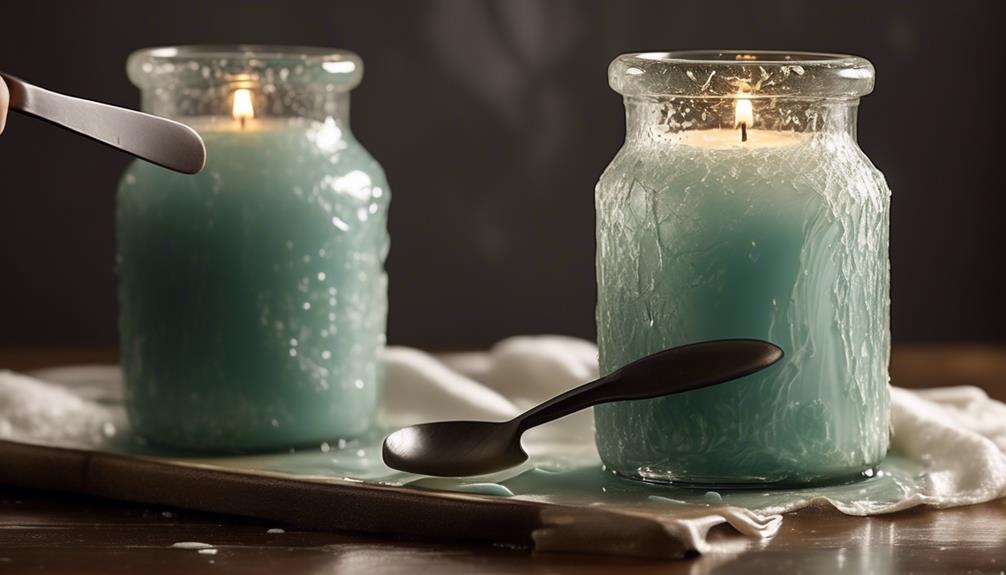
For efficient post-wax jar cleaning, consider utilizing different methods to effectively remove any remaining candle residue.
- Freezing Method: Place the spent candle jar in the freezer overnight, then flip it upside down. The frozen wax should pop right out.
- Boiling Water Method: Pour boiling water into the jar and let the wax float to the surface. Strain out the water and remaining candle bits.
- Oven Method: Heat the jars upside down on a baking sheet at 200 degrees Fahrenheit until the wax pools on the foil. Clean with soap and warm water.
These methods work well to ensure your post-wax jar is thoroughly cleaned and ready for repurposing or recycling.
Frequently Asked Questions
How Do You Get Leftover Candle Wax Out of a Jar?
We remove leftover candle wax from a jar by using various methods, such as boiling water, freezing, or heating in the oven. Another option is to soften the wax with a hair dryer and scrape it out.
Reusing leftover wax involves melting it and pouring it into a cleaned-out jar with a new wick or repurposing the jars for storage or decoration.
These techniques ensure a clean jar and allow for creative reuse of materials.
How Do You Remove Candle Wax From Glass?
Removing candle wax from glass is akin to peeling a stubborn sticker off a shiny surface.
First, place the glass in the freezer to harden the wax.
Next, gently pry the wax off with a butter knife.
If residue remains, heat the glass with a hairdryer and wipe it clean with a paper towel.
Lastly, wash the glass with warm, soapy water.
This method ensures your glass shines like new.
How Do You Get Wax Out of a Candle Holder?
We can remove wax from a candle holder using various methods.
One way is to pour boiling water into the holder, allowing the wax to float to the surface.
Alternatively, freezing the holder overnight can make the wax pop out easily.
Heating the holder in the oven or using a hairdryer to soften the wax are effective methods too.
Repurposing leftover wax and the holder for a new candle is a sustainable option.
How Do You Get Candle Wax Out of a Jar Bath and Body Works?
When it comes to getting candle wax out of a jar from Bath and Body Works, it can be a bit tricky. However, we've got some neat tricks up our sleeves.
From using hot water or the freezer method to popping out frozen wax, to melting it in the oven or with a hair dryer, there are various ways to tackle this task.
Let's dive into the details of each method to help you master this candle cleaning challenge.
Conclusion
And there you have it – a few simple ways to clean out a candle jar.
With a little bit of hot water, freezing, or even using your oven or hair dryer, you can easily remove the wax and have a sparkling clean jar ready for reuse.
Don't let those leftover candle remnants go to waste – try out these methods and enjoy your beautifully cleaned candle jars!
